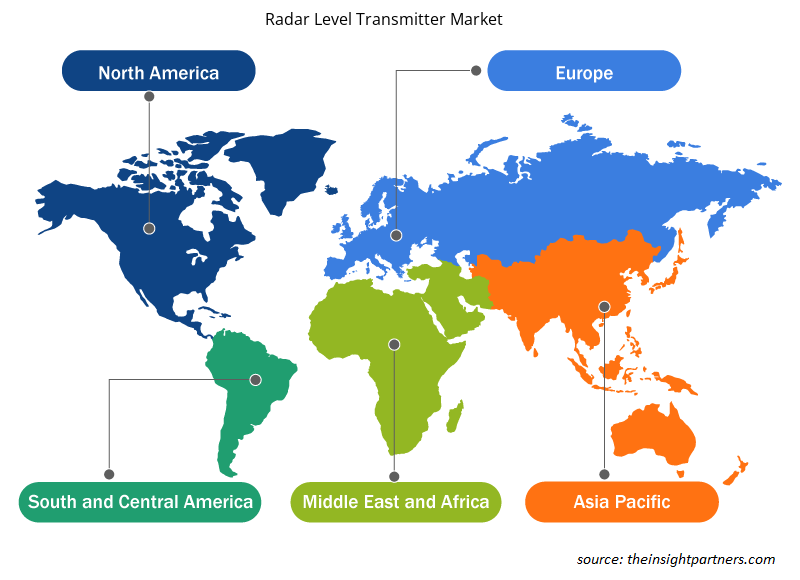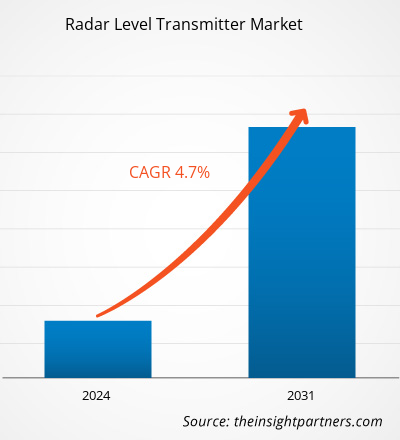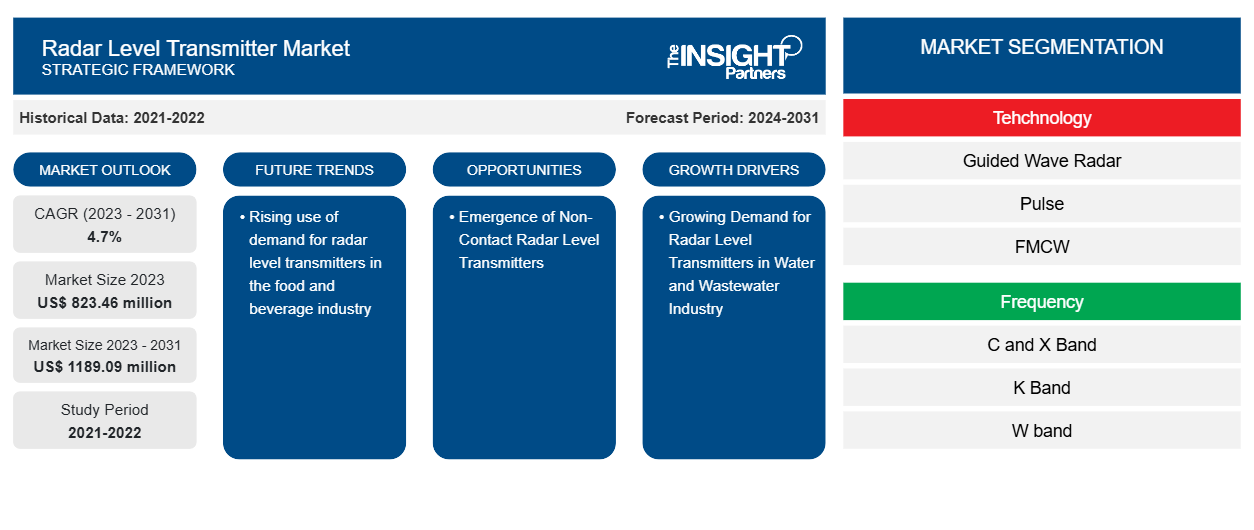من المتوقع أن يصل حجم سوق أجهزة إرسال مستوى الرادار إلى 1189.09 مليون دولار أمريكي بحلول عام 2031 من 823.46 مليون دولار أمريكي في عام 2023. ومن المتوقع أن يسجل السوق معدل نمو سنوي مركب بنسبة 4.7٪ في الفترة 2023-2031. ومن المرجح أن يظل الطلب المتزايد على أجهزة إرسال مستوى الرادار في صناعة الأغذية والمشروبات اتجاهًا رئيسيًا في السوق.
تحليل سوق أجهزة إرسال مستوى الرادار
ينمو سوق أجهزة إرسال مستوى الرادار بسبب فوائد الاستقرار العالي والموثوقية والدقة التي توفرها هذه الأجهزة. بالإضافة إلى ذلك، فإن التركيز المتزايد على تحسين الأصول وفعاليتها يعزز نمو السوق على المستوى العالمي. علاوة على ذلك، هناك طلب متزايد على أجهزة إرسال مستوى الرادار اللاسلكية، وخاصة للتطبيقات في المناطق النائية داخل قطاعات التعدين والنفط والغاز والكيميائيات والبتروكيماويات، مما يدفع نمو سوق أجهزة إرسال مستوى الرادار بشكل أكبر . علاوة على ذلك، فإن التحسينات الصناعية والاقتصادية المتوسعة في الاقتصادات الناشئة تخلق فرصًا جديدة للاعبين في السوق لتقديم حلول أكثر تقدمًا لعملائهم، مما يعزز نمو سوق أجهزة إرسال مستوى الرادار.
نظرة عامة على سوق أجهزة إرسال مستوى الرادار
أجهزة إرسال مستوى الرادار هي أجهزة إلكترونية تستخدم لقياس مستويات السوائل. تساعد أجهزة إرسال المستوى هذه في الكشف عن مستويات السوائل باستخدام تقنية الرادار. تستخدم العديد من الصناعات، بما في ذلك الأغذية والمشروبات والتصنيع والبناء والنفط والغاز والصناعة، تقنية إرسال مستوى الرادار على نطاق واسع. تعتمد هذه التقنية على حساب الوقت المطلوب لإكمال الرحلة بين المحول ومستوى المادة المقاسة. أجهزة إرسال مستوى الرادار هي الأنسب للبيئات القاسية عندما يمنع الضباب أو الغبار أو السطح الرغوي استخدام جهاز إرسال الموجات فوق الصوتية.
قم بتخصيص هذا التقرير ليناسب متطلباتك
ستحصل على تخصيص لأي تقرير - مجانًا - بما في ذلك أجزاء من هذا التقرير، أو تحليل على مستوى الدولة، وحزمة بيانات Excel، بالإضافة إلى الاستفادة من العروض والخصومات الرائعة للشركات الناشئة والجامعات
- احصل على أهم اتجاهات السوق الرئيسية لهذا التقرير.ستتضمن هذه العينة المجانية تحليلاً للبيانات، بدءًا من اتجاهات السوق وحتى التقديرات والتوقعات.
محركات وفرص سوق أجهزة إرسال مستوى الرادار
الطلب المتزايد على أجهزة إرسال مستوى الرادار في صناعة المياه والصرف الصحي
يتعرض قطاع إمدادات المياه لضغوط لتطوير تقنيات معالجة المياه مع نمو متطلبات جودة المياه المتسقة، وتصبح إدارة جودة المياه أكثر صرامة وقسوة. تعد تقنية جهاز إرسال مستوى الرادار بديلاً اقتصاديًا للغاية لمشاريع المياه وقادرة على قياس المستويات في ظروف قاسية. أثناء عملية معالجة مياه الصرف الصحي، يعد اختيار جهاز إرسال مستوى مياه الصرف الصحي المناسب أمرًا ضروريًا. تُستخدم أجهزة إرسال مستوى الرادار لمراقبة مستويات مياه الصرف الصحي في كل مرحلة من مراحل شبكة مياه الصرف الصحي وتقنية المعالجة، مما يوفر تحكمًا حاسمًا ومدخلات العملية، مما يغذي نمو سوق جهاز إرسال مستوى الرادار عالميًا.
ظهور أجهزة إرسال مستوى الرادار غير التلامسية
إن عدم التلامس هو الخيار الأفضل للتطبيقات غير النظيفة واللزجة والتآكلية، وكذلك عند استخدام المحركات. تستخدم أجهزة إرسال الرادار غير التلامسية تقنية الموجة المستمرة المعدلة بالتردد (FMCW) لتقييم المستويات. وعلاوة على ذلك، تُستخدم هذه الأجهزة لتحسين دقة القياس وموثوقيته ويمكن استخدامها لمجموعة أوسع من التطبيقات. وعلاوة على ذلك، تظل الدقة غير متأثرة بالاختلافات في كثافة الوسائط ودرجة الحرارة والغبار والضغط، وهو ما يُتوقع أن يخلق فرصة لنمو سوق أجهزة إرسال مستوى الرادار.
تقرير تحليلي لتجزئة سوق أجهزة إرسال مستوى الرادار
إن القطاعات الرئيسية التي ساهمت في اشتقاق تحليل سوق جهاز إرسال مستوى الرادار هي التكنولوجيا والتردد والوسائط والصناعة العمودية.
- استنادًا إلى التكنولوجيا، يتم تقسيم سوق أجهزة إرسال مستوى الرادار إلى رادار الموجة الموجهة والنبضة وFMCW. احتلت شريحة رادار الموجة الموجهة حصة سوقية أكبر في عام 2023.
- من حيث التردد، يتم تقسيم السوق إلى نطاق C&X ونطاق K ونطاق W. احتلت شريحة نطاق C&X الحصة الأكبر من السوق في عام 2023.
- بحسب الوسيط، يتم تقسيم السوق إلى صلب وسائل. وقد استحوذ القطاع الصلب على أكبر حصة من السوق في عام 2023.
- بحسب القطاع الصناعي، يتم تقسيم السوق إلى النفط والغاز والمواد الكيميائية والأغذية والمشروبات وغيرها. وقد احتل قطاع النفط والغاز الحصة الأكبر من السوق في عام 2023.
تحليل حصة سوق أجهزة إرسال مستوى الرادار حسب المنطقة الجغرافية
ينقسم النطاق الجغرافي لتقرير سوق جهاز إرسال مستوى الرادار بشكل أساسي إلى خمس مناطق: أمريكا الشمالية، ومنطقة آسيا والمحيط الهادئ، وأوروبا، والشرق الأوسط وأفريقيا، وأمريكا الجنوبية/أمريكا الجنوبية والوسطى.
تشهد منطقة الشرق الأوسط وأفريقيا نموًا هائلاً في أجهزة إرسال مستوى الرادار بسبب استخدامها الهائل في قطاعي النفط والغاز والمواد الكيميائية. ونظرًا لأن المنطقة من أكبر منتجي النفط والغاز، فإن الطلب على هذا الجهاز آخذ في الازدياد. ووفقًا لإدارة التجارة الدولية، تعد الإمارات العربية المتحدة واحدة من أكبر عشر دول منتجة للنفط في العالم. ويوجد حوالي 96% من احتياطيات النفط في البلاد، أي حوالي 100 مليار برميل، في أبو ظبي. وبالمثل، تمتلك المملكة العربية السعودية ما يقرب من 17% من احتياطيات النفط المؤكدة في العالم ، مما يجعل البلاد واحدة من أكبر الدول المصدرة للبترول. كما تمتلك البلاد ثاني أكبر احتياطيات نفطية مؤكدة في العالم. وعلاوة على ذلك، تتخذ حكومات البلدان المذكورة أعلاه مبادرات مختلفة لزيادة إنتاج النفط والبترول، مما يزيد من نمو سوق أجهزة إرسال مستوى الرادار.
رؤى إقليمية حول سوق أجهزة إرسال مستوى الرادار
لقد قام المحللون في Insight Partners بشرح الاتجاهات والعوامل الإقليمية المؤثرة على سوق أجهزة إرسال مستوى الرادار طوال فترة التوقعات بشكل شامل. يناقش هذا القسم أيضًا قطاعات سوق أجهزة إرسال مستوى الرادار والجغرافيا في جميع أنحاء أمريكا الشمالية وأوروبا ومنطقة آسيا والمحيط الهادئ والشرق الأوسط وأفريقيا وأمريكا الجنوبية والوسطى.

- احصل على البيانات الإقليمية المحددة لسوق أجهزة إرسال مستوى الرادار
نطاق تقرير سوق جهاز إرسال مستوى الرادار
| سمة التقرير | تفاصيل |
|---|---|
| حجم السوق في عام 2023 | 823.46 مليون دولار أمريكي |
| حجم السوق بحلول عام 2031 | 1189.09 مليون دولار أمريكي |
| معدل النمو السنوي المركب العالمي (2023 - 2031) | 4.7% |
| البيانات التاريخية | 2021-2022 |
| فترة التنبؤ | 2024-2031 |
| القطاعات المغطاة | بواسطة التكنولوجيا
|
| المناطق والدول المغطاة | أمريكا الشمالية
|
| قادة السوق وملفات تعريف الشركات الرئيسية |
|
كثافة اللاعبين في سوق أجهزة إرسال مستوى الرادار: فهم تأثيرها على ديناميكيات الأعمال
يشهد سوق أجهزة إرسال مستوى الرادار نموًا سريعًا، مدفوعًا بالطلب المتزايد من المستخدم النهائي بسبب عوامل مثل تفضيلات المستهلك المتطورة والتقدم التكنولوجي والوعي الأكبر بفوائد المنتج. ومع ارتفاع الطلب، تعمل الشركات على توسيع عروضها والابتكار لتلبية احتياجات المستهلكين والاستفادة من الاتجاهات الناشئة، مما يؤدي إلى زيادة نمو السوق.
تشير كثافة اللاعبين في السوق إلى توزيع الشركات أو المؤسسات العاملة في سوق أو صناعة معينة. وهي تشير إلى عدد المنافسين (اللاعبين في السوق) الموجودين في مساحة سوق معينة نسبة إلى حجمها أو قيمتها السوقية الإجمالية.
الشركات الرئيسية العاملة في سوق جهاز إرسال مستوى الرادار هي:
- أميتك
- أي بي بي
- شركة إيمرسون الكهربائية
- شركة هونيويل الدولية
- كرونه
- شنايدر الكتريك
إخلاء المسؤولية : الشركات المذكورة أعلاه ليست مرتبة بأي ترتيب معين.

- احصل على نظرة عامة على أهم اللاعبين الرئيسيين في سوق أجهزة إرسال مستوى الرادار
أخبار سوق أجهزة إرسال مستوى الرادار والتطورات الأخيرة
يتم تقييم سوق أجهزة إرسال مستوى الرادار من خلال جمع البيانات النوعية والكمية بعد البحث الأولي والثانوي، والذي يتضمن منشورات الشركات المهمة وبيانات الجمعيات وقواعد البيانات. فيما يلي قائمة بالتطورات في سوق اضطرابات الكلام واللغة والاستراتيجيات:
- أعلنت شركة KROHNE، Inc. عن إضافة ثلاثة أجهزة إرسال مستوى رادار OPTIWAVE بتردد 24 جيجاهرتز وثلاثة أجهزة إرسال بتردد 80 جيجاهرتز إلى خط منتجاتها، والتي تكمل الأجهزة الحالية بتردد 10 جيجاهرتز. إن المجموعة الكاملة من أجهزة إرسال مستوى الرادار OPTIWAVE ذات السلكين FMCW التي تعمل بالطاقة الحلقية للسوائل والمواد الصلبة مناسبة بشكل مثالي للصناعات من الكيماويات والبتروكيماويات إلى التعدين والمعادن ومعالجة المعادن وتغطي تطبيقات السوائل والمواد الصلبة. (بيان صحفي، 2022)
- أعلنت شركة إيمرسون عن تطوير جهاز إرسال المستوى Rosemount 1408H، وهو أول جهاز رادار غير تلامسي في العالم مصمم خصيصًا لصناعة الأغذية والمشروبات. تتضمن الميزات المخصصة تصميمًا صحيًا مضغوطًا وتقنية مسح سريعة وتركيزًا استثنائيًا لشعاع الرادار واتصالات IO-Link، مما يساعد الشركات المصنعة على تحسين كفاءة عملياتها وتقليل خسائر المنتجات وضمان سلامة الأغذية. (المصدر: إيمرسون، بيان صحفي، 2021)
تقرير سوق أجهزة إرسال مستوى الرادار والتغطية والمخرجات
يوفر تقرير "حجم سوق جهاز إرسال مستوى الرادار والتوقعات (2021-2031)" تحليلاً مفصلاً للسوق يغطي المجالات التالية:
- حجم السوق والتوقعات على المستويات العالمية والإقليمية والوطنية لجميع قطاعات السوق الرئيسية التي يغطيها النطاق
- ديناميكيات السوق مثل المحركات والقيود والفرص الرئيسية
- الاتجاهات المستقبلية الرئيسية
- تحليل مفصل لقوى PEST/Porter الخمس وSWOT
- تحليل السوق العالمي والإقليمي الذي يغطي اتجاهات السوق الرئيسية واللاعبين الرئيسيين واللوائح والتطورات الأخيرة في السوق
- تحليل المشهد الصناعي والمنافسة الذي يغطي تركيز السوق، وتحليل خريطة الحرارة، واللاعبين البارزين، والتطورات الأخيرة
- ملفات تعريف الشركة التفصيلية
- التحليل التاريخي (سنتان)، سنة الأساس، التوقعات (7 سنوات) مع معدل النمو السنوي المركب
- تحليل PEST و SWOT
- حجم السوق والقيمة / الحجم - عالمي، إقليمي، بلد
- الصناعة والمنافسة
- مجموعة بيانات إكسل
التقارير الحديثة
تقارير ذات صلة
شهادات العملاء
سبب الشراء
- اتخاذ قرارات مدروسة
- فهم ديناميكيات السوق
- تحليل المنافسة
- رؤى العملاء
- توقعات السوق
- تخفيف المخاطر
- التخطيط الاستراتيجي
- مبررات الاستثمار
- تحديد الأسواق الناشئة
- تحسين استراتيجيات التسويق
- تعزيز الكفاءة التشغيلية
- مواكبة التوجهات التنظيمية























 احصل على عينة مجانية ل - سوق أجهزة إرسال مستوى الرادار
احصل على عينة مجانية ل - سوق أجهزة إرسال مستوى الرادار